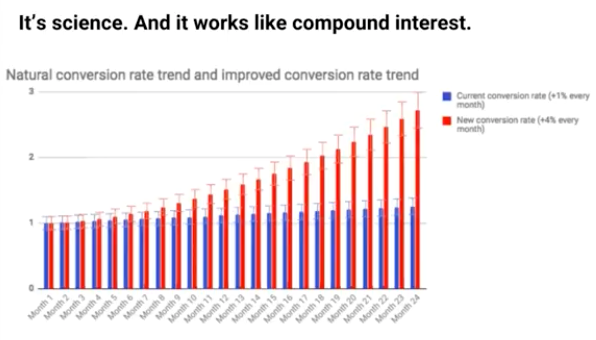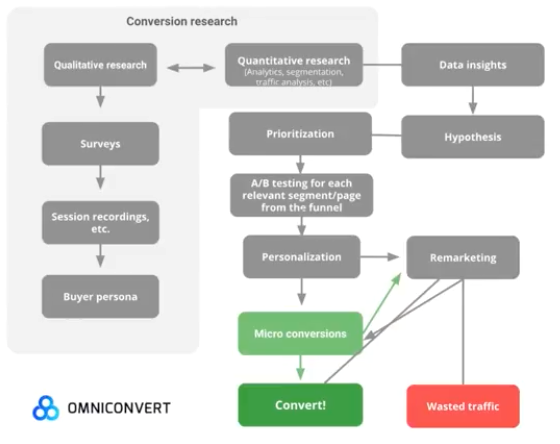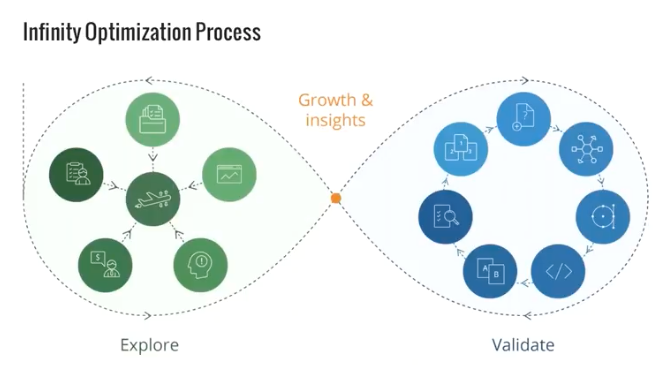Is conversion optimization magic? Is it only for people in a top-secret club you need a special password to join? Nope! It’s a pretty straightforward endeavor that follows a specific process, and anyone can learn to get good at it.
In two highly actionable sessions from our CommerceNow event, conversion optimization experts shared their insights on optimization and building a team and process to can carry it out successfully. Check out our summary below to get started, or watch the full sessions for a complete download on the topics.
What to find out what’s magic about conversion optimization? Then check out Maria Caciur’s session. We’ll give you a little sneak peek. Conversion optimization isn’t actually magic—it’s a science, and it even works like compound interest. The optimizations you invest in will keep performing and keep growing your revenue over time. The more you optimize, the more you profit!

Source: www.omniconvert.com
Where Conversion Optimization Really Starts (Hint: Not with a Test)
When most people think of conversion optimization, they think of one thing: testing. But there’s a lot that has to happen before you can run your first test. In order to know what to test, you need to understand your target customer. That means starting with research, such as surveys and site session recordings, that you can use to develop buyer personas. Along with qualitative research, you should conduct quantitative research into how your current pages are performing.
Finally, put all that data together to come up with your hypothesis and test plan.

As you test, don’t forget about micro conversions: clicks, signups and other forms of engagement, not just purchases, are important parts of your optimization process. Based on micro conversions, you can engage in targeted remarketing efforts that may lead to the conversions you ultimately crave.
Be Your Own Benchmark
As you develop your optimization program, it can be tempting to compare yourself to other companies and how they’re doing. Keep in mind that not everyone is at the same stage in the optimization journey. When you’re just getting started, your best benchmark is your own past performance, as any increase in conversion at all is going to grow your business. Over time, you may want to look for industry benchmarks and make sure your performance aligns with them, but don’t let others distract you from the main goal: to be better than you were before.
Ready for the next step in your path toward optimization everywhere? Let’s talk about building an experimentation engine.
Once you understand the basics of optimization, it’s time to build an ongoing experimentation engine in your organization and make testing part of your everyday DNA instead of a special undertaking. Chris Goward of WiderFunnel has designed a way to embed what he calls the “zen marketing mindset,” a union of creative and analytical perspectives, into your optimization process to achieve the best possible results: optimizing the process of optimization, basically.
If you can’t describe what you’re doing, you don’t have a process, and you’re missing out on ways you could streamline your methodology. Fortunately, the Growth Program PACET™ combines the key steps of Process, Accountability, Culture, Expertise, and Technology to give your company a solid foundation for successful experimentation, optimization, and growth.

Everything Starts with Process
Marketers are in an infinity optimization process because optimization is an ongoing process, not a one-off project you can just complete and check off your list forever. While you may focus on optimizing different pages, experiences or other aspects of your site, your overall optimization mindset should never go away. The components of the process include exploration through research, analytics, persuasion, context and testing, which all feed into to the LIFT model, a way to conceive of how your customers perceive your value proposition.

Source: www.widerfunnel.com
Relevance and clarity lift up your value proposition, while distraction and anxiety take away from it. The whole process is fueled by urgency. Of course, make sure to validate your explorations by making sure what’s tested really works.
Don’t Make Me Think!
One simple approach to optimization can be to reduce cognitive strain, or information overload, on the customer. Cognitive strain tends to overwhelm customers and deter them from purchasing. One company reduced strain by testing a “needs selector” that focused on customer needs versus a “product selector” that focused on product features. Because the needs selector avoided cognitive strain by making the selection about the customer, rather than forcing the customer to try and understand product details, it resulted in a 41.4% increase in conversion rate (compared with only 15.8% for the product selector).
This growth showcases the need to try many new things: if the product selector alone had been tested against another control, it could have seemed like a great uplift, but the company had the potential to do even better by building the needs selector. The success of the needs selector also shows that insight-driven experiments, like this one focused on the need to reduce customer cognitive load, can produce dramatic business improvements, fast. In a similar vein, another test found that making a product video less prominent actually brought in more sales, because the farther along in the funnel a customer gets, video education can actually be a distraction from what the customer really needs.
Get Inside Their Heads
One great way to get customer-focused and insight-driven is to use popups or exit forms to understand why your customers left your site and what was missing. You can even do this cleverly: for example, the nonprofit Heifer International asks visitors to self-identify as a regular donor, occasional donor or first-time donor. Simply asking all visitors to characterize themselves as donors increased conversion 2%, donations 3% and revenue per visitor 5%. Now that’s smart!
Scale Optimization Efforts with Your Company
Your approach to optimization will vary depending on where you are in your company’s growth. Early-stage companies tend to invest most in complex test development and conduct lots of testing to understand their audience. As your company scales, you’ll have a larger stockpile of information on which to base a strategy, and your strategy team will begin to match your development team in size. This will enable you to test fewer, but better, ideas in your optimization journey. A more mature company will also be able to focus more on using persuasion principles in the optimization process.
Test as Long as You Need To
The length of time to run your tests will be determined by a few factors, including how much traffic you get. More traffic can mean shorter tests, but you should be looking for a certain volume of traffic as well as a certain improvement in conversion rate. For many companies, running a test for a week, often spanning two weekends, can be useful, but the time for each test can vary by company.
By adopting the PACET model and thinking about customer needs, you can successfully optimize your online sales and compound the growth of your business.
Need more tips? Check out our other resources.





